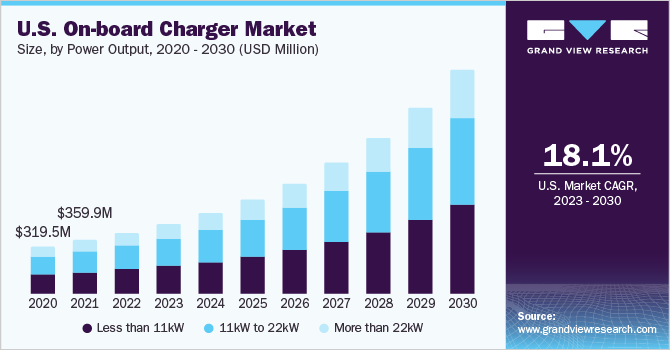On-board Charger Market Share and Business Opportunity to 2028
On-board Charger Industry Overview
The global on-board charger market size was valued at USD 4.05 billion in 2020 and is expected to expand at a compound annual growth rate (CAGR) of 17.2% from 2021 to 2028.
The high cost of charging an electric vehicle at public charging stations is creating the demand for on-board chargers in the current days. The public chargers near highways, malls, and workplaces are subject to commercial electric rates, which are higher as compared to residential rates. This is creating the need for on-board chargers for an electric vehicle. An on-board charger is used in an electric vehicle for charging the traction battery by converting the AC input received from the grid to the DC input required to charge the batteries. The increase in the number of AC private and public charging stations across the globe is one of the major factors driving the market growth. The AC level 1 on-board charger is deployed in all types of electric vehicles and can be plugged into ordinary power outlets.
Gather more insights about the market drivers, restrains and growth of the Global On-board Charger Market

This type of charger is in demand among the users as it does not require additional electric work, which minimizes the overall cost of installation. Additionally, approvals received for AC Level 2 charging stations are also one of the major factors accentuating the market growth. For instance, in October 2020, EVBox, an electric vehicle charging infrastructure provider, announced that its EVBox Iqon, a level 2 commercial charging station, received a UL certificate and is now available for installation across North America.
Silicon carbide semiconductor technology is increasingly being used for manufacturing on-board chargers as it provides high power density with an efficiency rate of more than 98%. Various companies are thereby increasing their focus on providing higher power and more efficient silicon carbide on-board chargers, which is creating new opportunities for market growth. For instance, in January 2020, Innolectric, an on-board charger provider, announced the launch of a 22-kW silicon carbide on-board charger. This new charger was developed by the company under its partnership with STMicroelectronics.
The increasing deployment of electric charging stations worldwide is propelling the market growth. For instance, in February 2021, Shell announced the plan of deploying 500,000 electric charging stations by 2025. On-board chargers are deployed in an electric vehicle that supports AC level 1 and level 2 charging. According to the study published by Idaho National Laboratory, 8% of the charging of Nissan Leaf is carried through DC fast chargers and the rest of the charging is done through AC level 1 and level 2 chargers.
The installation cost of an AC charging station is low compared to DC charging stations. The average cost required for installing a level 2 residential charger is approximately USD 1,354, which includes upgraded electrical services that are necessary for old homes. Additionally, the installation of a workplace level 2 charging station costs USD 2,223. However, the installation of fast DC chargers costs USD 22,626 and requires additional electrical services, owing to which, the demand for AC charging stations is increasing, ultimately accentuating the growth of the on-board charger market.
Browse through Grand View Research's Automotive & Transportation Industry Research Reports.
- Electric Vehicle Market - The global electric vehicle market demand was estimated at 2,373.5 thousand units in 2019 and is expected to witness a CAGR of 41.5% 2020 to 2027.
- Electric Vehicle Charging Infrastructure Market - The global electric vehicle charging infrastructure market size was valued at USD 19.26 billion in 2021 and is expected to expand at a compound annual growth rate (CAGR) of 30.6% from 2022 to 2030.
Market Share Insights
- March 2021: Eaton announced the acquisition of Green Motion SA, a manufacturer and designer of electric vehicle charging software and hardware. Through this acquisition, Eaton expanded its electric charging capabilities.
- February 2021: Shell announced the plan of deploying 500,000 electric charging stations by 2025. On-board chargers are deployed in an electric vehicle that supports AC level 1 and level 2 charging. According to the study published by Idaho National Laboratory, 8% of the charging of Nissan Leaf is carried through DC fast chargers and the rest of the charging is done through AC level 1 and level 2 chargers.
- January 2019: Eaton announced its partnership with KPIT. Under this partnership, the company developed next-generation technologies for e-mobility. This partnership was mainly focused on deploying and developing software solutions, technologies, and platforms for on-board chargers and DC-DC converters.
Key Companies profiled:
Some prominent players in the global on-board charger market include
- Bel Fuse Inc.
- Delta Energy Systems
- STMicroelectronics
- Toyota Industries Corporation
- Eaton
- Stercom Power Solutions GmbH
- innolectric AG
- BRUSA Elektronik AG
- AVID Technology Limited
- Ficosa Internacional SA
Order a free sample PDF of the On-board Charger Market Intelligence Study, published by Grand View Research.
Comments
Post a Comment